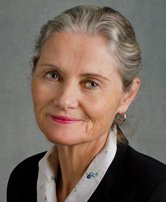Northwestern Kellogg MBA Class of 2020: 46 Percent Women, 27 Percent U.S. Minorities

Northwestern University’s Kellogg School of Management announced today that women will make up 46 percent of the incoming two-year, full-time MBA Class of 2020. That’s a four-percentage point jump over last year and a record high for the school. U.S. minorities are also up—comprising 27 percent of this year’s first-year students, as compared to 25 percent last year. Meanwhile, average GMAT (732) and GPA (3.6) were identical to last year. Class size also remained constant at 478.
“I am very, very thrilled with the diversity of the class,” Melissa Rapp, Kellogg Director of Admissions for full-time MBA and MSMS programs, told Clear Admit. “And not just because of the percentages but also the quality of candidates across the board,” she said. International students will make up 34 percent of the incoming class, drawn from 46 countries around the globe, a modest one-percentage point decline amid soft overall international applicant volume to U.S. schools.
Rapp pledged that she and her team will keep striving to attract the most diverse classes possible. “I firmly believe that diversity in the classroom leads to better learning and a more impactful experience for every student who is here,” she said.
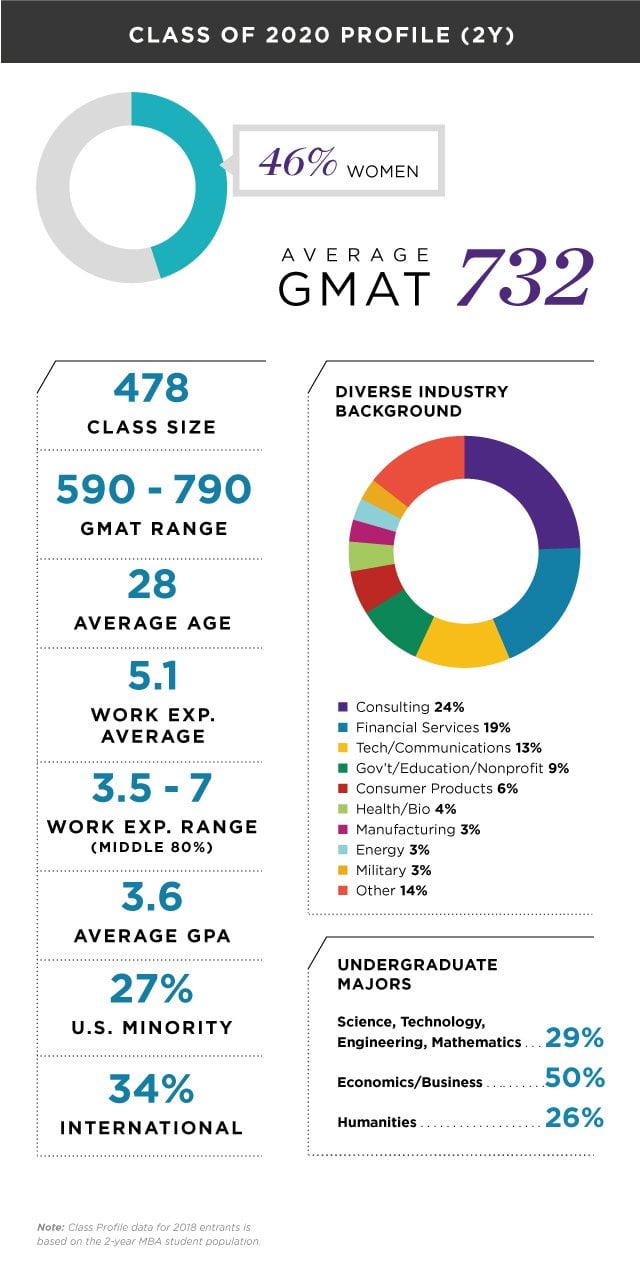
Steady State Elsewhere Is Great
For the past six years Kellogg’s average GMAT score has been on the rise, climbing from 708 in 2012 to 732 last year. Rapp said she is not at all concerned to have it remain static at 732 this year. “That our average GMAT and GPA have stayed the same shows that we continue to attract a really outstanding pool of applicants year after year,” she said.
Average undergraduate GPA also didn’t budge—coming in at 3.6 for now the third year running. As for what applicants studied while in college, 50 percent of this year’s incoming class majored in business or economics, up from 49 percent last year and 45 percent the year before that. STEM majors fell slightly to 29 percent, down from 30 percent the year before. Humanities majors both this year and last made up the remaining 26 percent.
Varied Professional Experience
In terms of pre-MBA work experience, approximately one in four incoming Kellogg students—24 percent—come from consulting, down from 27 percent last year. Another 19 percent come from the financial services industry, also a slight decrease from last year’s 20 percent.
Up this year? Students who have worked in tech/communications grew from 12 to 13 percent. “I think the changes that we see in our class really reflect the changes that we see in the business world,” Rapp said. “There are more people from tech, which is not surprising for anyone since there is more tech in the world than there ever has been.” Students with government/education/nonprofit experience also increased, from 7 to 9 percent.
Overall Rapp is pleased to see Kellogg continuing to attract a wide range of students from across functions and industries. “The variety continues to be very strong both in terms of our incoming students and our outgoing graduates,” she added. “Again, those differences and that diversity is what makes the Kellogg experience so strong.”
Kellogg’s Efforts to Support Women May Off
By far the biggest news today is that Kellogg has come closer than ever before to gender parity with its newest incoming class. USC Marshall School of Business made headlines last month by becoming the first leading business school to cross the 50/50 mark—women will make up 52 percent of the Marshall Class of 2020, a staggering 20-percentage-point jump over last year. At UT Austin’s McCombs School, which has also shared a preliminary Class of 2020 profile, the percentage of women slipped year over year, from 40 to 38 percent. And at Cornell’s Johnson Graduate School of Management, which welcomed it new Class of 2020 students to campus last week, women make up 33 percent, a five-point gain over last year.
“It’s really pretty exciting,” said Rapp of Kellogg’s 46 percent women. She credits the gains in female enrollment in part to the vision and leadership of outgoing Kellogg Dean Sally Blount, who served as dean from 2010 until she stepped this past spring.
Kellogg has also called on its current female students, including members of the Kellogg’s student-led Women’s Business Association (WBA), to take part in admissions outreach activities in hopes that they can forge meaningful connections with prospective female candidates early in their exploration process.
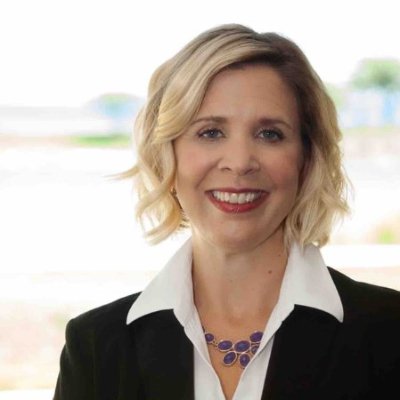
Melissa Rapp, Kellogg Director of Admissions for the full-time MBA and MSMS programs.
New this year, the school also convened its inaugural Global Women’s Summit in May. More than 1,200 women participated “live”—with 800 at Kellogg’s Global Hub in Evanston and the rest via extension events in London, Hong Kong, New York, Boston, San Francisco, Miami, Seattle, and Chicago hosted by companies including Amazon, Microsoft, and Starbucks. Over the course of the two-day event, the #KelloggWomen hashtag was trending in Chicago and generated 2.7 million overall impressions. “The breadth of engagement the summit allowed for provided a really nice bridge from prospectives to current students to our alumnae population,” Rapp said.
Kellogg also this year hosted its third-annual Women’s Leadership Seminar, a unique five-week lineup for second-year MBA students combining lectures, workshops, networking events, and alumni panels on recruiting issues women face. “The goal is to ensure that our high-potential women are equipped to pursue and navigate careers that have deep personal and professional meaning,” Rapp said.
“This combination of everything from lunch and learns to seminars to summits really helps the women here know that Kellogg understands the unique situation they are in and the challenges they will face on their journey to become impactful leaders and is proactively talking about that and helping them navigate that.”
Those Kellogg women, it seems, have been doing a good job of helping prospective female applicants see Kellogg as a place they want to be, too.
This article has been edited and republished with permissions from our sister site, Clear Admit.
GMAT Scores, International Students Jump at NYU Stern
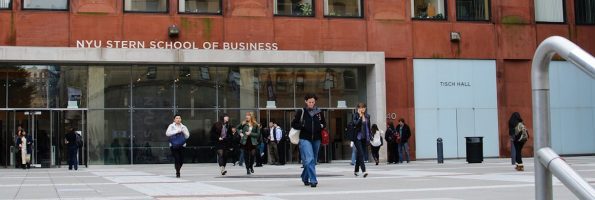
Last week, the NYU Stern School of Business shared a preliminary profile of its Class of 2020. Even amid some declines, the school showed gains in the diversity of its class and added a few points to the average GMAT score for incoming students.
This year saw 3,781 applicants—down from 3,927 for the Class of 2019. Among the new applicants, 876 were admitted (23 percent) and a total of 375 enrolled. Last year, 822 applicants were admitted (21 percent), yielding 402 enrolled students.
Although the percentage of female students dropped slightly from the previous year (38 to 35 percent), the Class of 2020 is more global than the Class of 2019. International students increased from 37 percent last year to 39 percent, even as overall international MBA application volume to U.S. schools faltered.
“International applications were down about 10 percent this year, but they still represent about half of total applications, so we had a very strong pool of applications from which to admit,” an NYU spokesperson says.
The percentage of minority students held steady at 29 percent—the same as the previous year. But of those, 13 percent this year are underrepresented minorities (U.S. citizens and permanent residents who identify as African American/Black, Hispanic, or Native American/Alaskan Native), up 2 percentage points over the Class of 2019.
The average GMAT score for incoming students this year increased to 717—a three-point gain over the previous class. However, the median GMAT maintained the same score as the previous class, sitting at 720. At the same time, applicants opting to submit GRE scores instead of GMAT scores jumped from 12 to 19 percent, while the average GPA slipped slightly from 3.48 to 3.45.

The NYU Stern Class of 2020 sported a 717 GMAT average; three points higher than the previous class.
The Class of 2020 has a diverse educational background. Approximately 29 percent of students studied business as undergrads, more than any other major. Another 20 percent of the incoming class have degrees in engineering, math, and science. Economics, humanities, and social sciences majors make up the rest of the class, totaling 18 percent, 17 percent, and 16 percent, respectively.
Stern also continued its efforts to recruit military veterans and active duty service members, including through the Fertitta Veterans Program. Now in its second year, the program underwrites more than half of the tuition bill for approximately 20 incoming students annually. Veterans and active duty service members comprise 7 percent of the Class of 2020, similar to last year.
The average work experience among incoming students increased from 4.9 years for the Class of 2019 to to 5.3 years this year. More than a quarter—26 percent—of the Class of 2020 comes in with previous experience working in financial services, and another 13 percent come from consulting. The three next largest feeder industries are technology, entertainment/media, and military/government, making up 9 percent, 7 percent, and 7 percent, respectively. With regard to post-MBA career aspirations, members of the Class of 2020 are increasingly interested in consulting, technology, entrepreneurship, and healthcare.
Click here or more information on the NYU Stern Class of 2020.
This article has been edited and republished with permissions from our sister site, Clear Admit.
Harvard Adcom Director Launches Application Tips Series
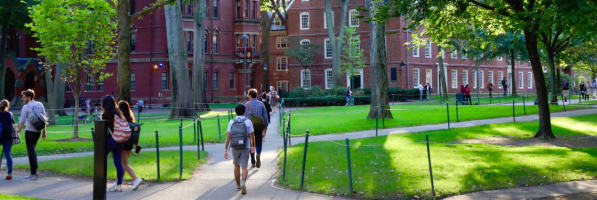
Clear Admit recently spoke with Chad Losee, the Managing Director of Admissions and Financial Aid at the Harvard Business School, which you can read in full below.
Clear Admit had the pleasure of sitting down with Harvard Business School Managing Director of Admissions and Financial Aid Chad Losee a few weeks ago when we were in Boston for the annual Graduate Management Admission Council conference. Losee shared then his plans to launch an Application Tips series on his blog. True to his word, he kicked things off earlier this month.
Each week, he plans to tackle a different element of the application, offering suggestions for how to approach it and clearing up any misconceptions applicants may have. “My goal is to demystify the written application and give you some simple, practical suggestions for putting together your story,” he wrote.“When July hits, I know from personal experience that applying starts to feel ‘real’ when you are planning to apply to HBS in Round 1,” he wrote. He’s referring, of course, to his own application process to HBS not all that long ago. (He’s a 2013 graduate of the MBA program.)
Up first, in a July 13 post to his Direct from the Director Blog, he turned his focus to the “Employment History” section of the application. “I think there’s a temptation to just ‘go through the motions’ in this part of the app—maybe because it feels similar to your resume?” he wrote. But doing so means missing a valuable opportunity to help the HBS admissions team really get to know you.
“The employment history section ought to be one of the more self-reflective parts of the application as you step back and take stock of your journey so far,” Losee advised. “Don’t be afraid to show a little personality in your responses!”
This means taking full advantage of the 250-charcter text boxes you’re given to provide details about your most recent three jobs, including your role and responsibilities, company/organization description, reason for leaving, key accomplishments, and most significant challenge.

HBS Managing Director of Admissions and Financial Aid Chad Losee
Use your own words—not an HR job posting or company boilerplate—to explain the most important aspects of your individual role as well as the specific division or team you are a part if you work for a large well-known company. “If you work at a startup or your family business, giving us details beyond what is available online is also very helpful,” he added.
Your reason for leaving can be simple and straightforward. But take the opportunity to “reflect on the ‘why’ of a key transition in your work life,” Losee continued. And do more than simply list key accomplishments or significant challenges—communicate why they were meaningful to you.
Losee will zero in on the essay portion of the application in his next post in the series, followed by recommendations, standardized tests/transcripts, awards/extracurriculars, and résumé.
We think it’s great that he’s taking the time to demystify the HBS admissions process. If you’re gearing up to apply, you certainly don’t want to miss out on what he shared. We’ll capture the essence of his subsequent posts in recaps here, but you can also visit his blog yourself. HBS will also share the tips via Instagram, so if that’s more your jam, you can follow along at @hbsadmissions.
Losee did confess to one hesitation at the outset of the series, namely that applicants might try to follow his suggestions too closely. “The written app is for you to introduce yourself—we designed a lot of ‘space’ in the app for you to tell your story,” he stressed. “If you’re following a rote/cookie-cutter approach we won’t be able to get to know you. So, promise you won’t do that?”
The new “Application Tips” series complements other scheduled HBS events and webinars—be sure to add those to your calendar as well.
Northwestern Kellogg Names Kathleen Hagerty Interim Dean

Following last year’s surprising announcement that Northwestern University Kellogg School of Management dean Sally Blount will step down from her role, provost Jonathan Holloway has announced that Kathleen Hagerty will serve as the interim dean while the school continues its search for a long-term replacement.
Blount, one of the only female deans to ever lead an M7 business school, has left behind an extraordinary legacy of fundraising and academic development. Her replacement certainly has big shoes to fill.
Holloway believes that Hagerty will do an excellent job in her new position as interim dean. “I am confident that Kathleen will provide a seamless transition when dean Blount steps down later this summer and until we conclude our search,” Holloway said.
Both Hagerty’s record of service and pedigree—including a Berkeley Haas MBA and a Stanford Ph.D.—may prove that the confidence is not misplaced.
Hagerty has been with Northwestern Kellogg in a teaching or leadership position for more than 30 years. She currently holds the First Chicago Professorship in Finance, and her research focuses on the micro-structure of securities markets, disclosure regulation, insider trader regulation, and the efficacy of self-regulatory organizations. Hagerty’s research has been published in various books as well as in prestigious finance journals such as the Quarterly Journal of Economics and the Journal of Financial Intermediation.
Hagerty currently serves as the senior associate dean of faculty and research at Kellogg, a position she previously held from 2010 to 2015. She also has occupied various other leadership positions during her time at Northwestern, including two terms as chair of the finance department and a two-year term as faculty director of Kellogg’s Ph.D. programs.
Hagerty has also gained a reputation as an excellent scholar and respected faculty leader who can attract and retain world-class academic talent in an extremely competitive market. In addition, she has contributed immensely to the development of various academic programs for both graduate and undergraduate students at Kellogg.
Hagerty shared her thoughts about being appointed interim dean:
“I’m honored to assume this role and add to the myriad accomplishments of the Kellogg team under Dean Blount’s leadership. I look forward to partnering with faculty colleagues, as well as our staff, students, alumni and broader community, to create knowledge and educate the next generation of business leaders.”
Blount, who officially steps down on August 31, is quite happy with the announcement of Hagerty as the interim dean, describing her as a valuable member of the Kellogg community.
“As a long-time member of the Kellogg faculty, no one knows the school better or has a stronger commitment to our mission than Kathleen,” Blount remarked.
She continued, “She is a deep believer in business education and a highly effective leader. I’m confident that she will maintain Kellogg’s upward trajectory and ensure continuity of everything we love about Kellogg.”
After she completes her term as interim dean, Hagerty will move into the Northwestern University Office of the Provost and serve as associate provost for faculty. In this new role, she will support about 3,700 faculty members as well as develop and execute the strategic vision of faculty.
Given her knowledge of the Kellogg community and its various members, Hagerty will be able to continue the work that dean Blount has done over the past seven years and create a rock solid foundation for the next dean, whenever they may arrive. Stay tuned with Clear Admit as the search for the next Northwestern Kellogg dean continues.
This article has been edited and republished with permissions from our sister site, Clear Admit.
State-of-the-Art Marion Anderson Hall Launching UCLA into the Future
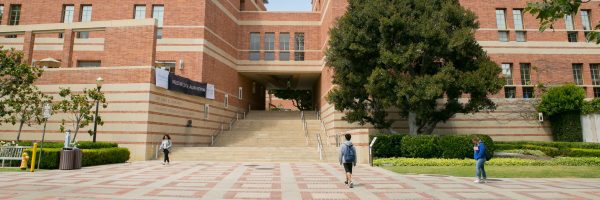
Last fall, UCLA Anderson School of Management broke ground on Marion Anderson Hall, a new state-of-the-art facility designed as a “blueprint for the future” of the school.
Developed in response to the dramatic expansion in programming, student body, and faculty that UCLA Anderson has experienced in the past 23 years, Marion Anderson Hall expands the existing cluster of five interconnected buildings that comprise the UCLA Anderson campus.
As the new primary entrance to the UCLA Anderson campus, the building will serve as both a symbolic and functional gateway to the school. Its design seeks to complement the school’s existing visual identity as it moves into the future, providing a space for students to “think in the next.”

A prototype image of the new Marion Anderson Hall / Photo via UCLA.edu
The building’s design softens harder institutional edges with partial green roofs, access to daylight, and external walkways. It provides small clusters of seating and multi-function nooks and gathering spaces throughout, as well as team-based and active-learning workrooms to facilitate connection and collaboration. The building also exceeds LEED-certification guidelines.
At four stories and 64,000 square feet, Marion Anderson Hall significantly increases the Anderson campus reach. It will use UCLA’s signature four-color blended brick on the exterior and soften the lower roof line with areas of green roofing.
The building will contain acoustically optimized office and classroom spaces with adjustable window glazing. The upper levels will open to a central atrium, which will contain a double-height event space. The exterior will be open to Briskin Plaza on one side and approachable by car on the other.
The architects of the new Marion Anderson Hall are the award-winning PEI Cobb Fried and Partners, a firm known for its environmental sensitivity and its attention to the shaping of the public realm.
UCLA Anderson’s student body has expanded 64 percent since 1995 as it has grown from three degree programs to eight. It now offers a Ph.D., Executive MBA, master’s of financial engineering, master’s of science in business analytics, and two tracks of UCLA-NUS Executive MBA in partnership with the University of Singapore Business School. The new building will accommodate this expansion and provide opportunities for future growth.
The late Marion Anderson, the building’s namesake, is one of UCLA Anderson’s key donors. She and her husband, John Anderson (BS ’40), donated $100 million in May 2015, the largest gift UCLA has ever received. Much of her gift was dedicated to new fellowships and research, but a substantial $40 million was earmarked for the development and construction of a new state-of-the-art building.
As a long-time pillar of leadership and support for UCLA Anderson, Marion Anderson wanted to bring the school into the future. She served on the Board of Advisors and was active in learning about the needs and opportunities of the school. She often attended events and enjoyed getting to know faculty and students. She passed away on May 17, 2017. The building will serve as a reminder of her and her vast legacy of leadership and support.
Sam Tang (MBA ‘87) chose the loft as the area for his naming gift. He imagines the Tang Family Loft as a place to gather, connect, and think big-picture and elevated thoughts.
Marion Anderson Hall reinforces UCLA Anderson’s strategic plan for 2021, “One Anderson,” which involves strengthening connections within the Anderson community, as well as to the outside world. Other goals include increased relevance, more diversity and inclusion, and an elevated social mission.
You can learn more about Marion Anderson Hall here and take a look at the building below.
This article has been edited and republished with permissions from our sister site, Clear Admit.
Kellogg Admissions Director Shares Insights on 2019 MBA Application

Northwestern University’s Kellogg School of Management is one of several leading business schools to release its 2019-2020 MBA application online within the last week. At Kellogg, deadlines for the upcoming admission season are as follow:
- September 19, 2018
- January 9, 2019
- April 10, 2019
To help you get started, Director of Admissions Melissa Rapp provided insight into the 2019 MBA application along with some great advice on how to prepare. We’ve shared some of the most pertinent details below.
Written Essay Questions Remain Unchanged
The Kellogg written essay questions remain the same this year as last. Applicants will need to answer the following two questions.
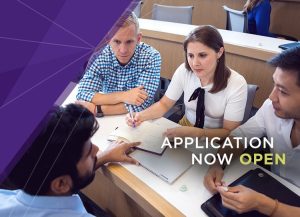
- Tell us about a time you have demonstrated leadership and created lasting value.
To answer this question, MBA applicants should think about a specific challenge they have faced in their career and how they overcame it. Specifically, Rapp advises applicants to think about their contribution to their organization and the lasting value they created.
- How have you grown in the past? How do you intend to grow at Kellogg?
This question is about looking at both past performance and future behavior. Remember to keep in mind the reason why you’re pursuing an MBA in your answer.
Video Essay Advice
For four years, MBA applicants have been expected to complete a video essay, and this interview season is no different. Rapp recommends using your video essay as your chance to tell your story in your voice. In the video portion, you’ll answer three questions:
- What path are you interested in pursuing? How will you get there?
- Why is this program right for you?
- Randomly generated question about overcoming obstacles.
When answering these questions, Rapp encourages applicants to speak from the heart and to avoid repeating phrases from their written essay. You’ll have a few practice questions to help you get comfortable; then, they’ll dive straight into the official questions. Think of the video portion like an interview more than an essay.
As for the technology, the Kellogg technical team is available 24/7 with questions or concerns, though Rapp says few if any candidates struggle.
Focus on Your Unique Qualities
In this most recent blog post, Rapp also underscored Kellogg’s focus on diversity and inclusion. Specifically, she explained that the school is interested in a broad range of backgrounds, experiences, perspectives, and opinions. So, be confident in telling your story and what makes you unique. That’s what the admissions team wants to hear all about.
To read the full article and learn more about the 2019 MBA application, visit the Kellogg website.

